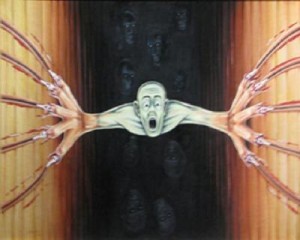Have some mercy, kill me!
Dr. Kevorkian dies at the age of 83 on June 3rd, 2011. (CNN blog-reports “Dr. Jack Kevorkian dead at 83”)
Dr. Death is the name given to a pathologist Jack Kevorkian. He made the headlines of national news in early 1990s for his legislation of a “right-to-die”. Is Dr. Death a murderer?
Early life
Jacob “Jack” Kevorkian, or Hagop Kevorkian, was born in Pontiac, Michigan, to a family of immigrants from Armenia. His mother Satenig and her family escaped Armenian genocide in 1915 and eventually immigrated to Pontiac where she met his father Levon. The couple had a daughter, Margaret, son Jacob, and lastly, daughter, Flora.
Kevorkian, who taught himself German and Japanese, graduated from Pontiac Central High School with honours in 1945, at the age of 17. In 1952, he graduated from the University of Michigan Medical School.
Career
Kevorkian’s career begins in 1980s with a series of articles written for the German journal Medicine and Law capturing his views on euthanasia. He started advertising in newspapers as a physician consultant for “death-counselling”. His first assisted suicide was of Janet Adkins who suffered from Alzheimer’s disease. He was charged of murder, but charges were dropped because of no law in Michigan regarding assisted suicides. However, a year later his medical licence was taken away and he was no longer allowed to work with patients. This did not stop Dr. Kevorkian from assistance of over 130 deaths from 1990 to 1998.
Methods
In each of the cases, when patient agreed to death, Kevorkian assisted by attaching them to a euthanasia device that he made. The individual then pressed a button that would end their own life. Two people were assisted by “Thanatron” (death machine), others with “Mercitron” that had a gas mask filler with carbon monoxide.
Later career, imprisonment
In 2010 interview with Sanjay Gupta, Kevorkian stated “what difference does it make if someone is terminal? We are all terminal”. He also mentioned that he declined four out of five requests, on the grounds of possible treatment.
On November 22, 1998 Kevorkian allowed videotaping Thomas Youk’s,52, voluntary euthanasia, who was in final stage of lateral sclerosis. In this act Kevorkian injected Youk. During the videotape, Kevorkian dared the authorities to try and stop him from carrying mercy killing. After that incident going on public, Kevorkian was charged with second-degree murder and sentenced to serve 10-25 year in prison. He spent eight years and 2.5 months in prison before he was paroled for good behaviour in 2007. He was paroled under the conditions that he cannot practice medicine or provide care to anyone older than 62 or disabled. He was also forbidden from making comments about his assisted suicides.
Death
Kevorkian suffered from kidney problems for years and had been diagnosed with liver cancer. He was hospitalized in May, 2011 and died in June of the same year.
Dr. Kevorkian was a jazz musician, composer and an oil painter. He sometimes painted with his own blood. Of his known works, six were made available in the 1990s for print release.
“You don’t know Jack” premiered on April 24th, 2010 with Al Pacino as Jack Kevorkian.
See also
– God bless you, Dr. Kevorkian



October 13th, 2011 at 8:49 pm
This is really interesting to me. I feel as if medicine should be focusing on making lives better but it gets caught up in life preservation. I don’t think assisted suicide is the answer for a lot of problems but it is the answer for some. I really think Dr. Kevorkian was an amazing person for devoting his life to this and I hope one day that assisted suicide will lose some of its bad rap and it can actually used to save people from suffering. Very interesting post.
October 14th, 2011 at 6:36 pm
People often desire to live as long as they can, but I don’t think they would if they had to endure pain and suffering. I agree with Christina. There are indeed situations in which euthanasia can be very appropriate. I know I would choose euthanasia if I were in a similar situation in which treatment were impossible or I would be in extreme pain either way.
I take it the pictures you used in this blog were Dr. Kevorkian’s own artwork? I like his unique style of art.
October 14th, 2011 at 8:45 pm
I also wondered about the artwork in the post. Is it his work? The other thing I really wanted to know was how exactly he died — naturally? Or, did he get the opportunity to choose for himself, like he helped many others do?
October 14th, 2011 at 11:06 pm
Sorry, I couldn’t figure out how to add captions to pictures of the paintings. Yes, those are his paintings. The first one is called Nearer May God to Thee (1994), the one after that is called “Fever” (1994) and last one is “Very still life” (1996).
Kevorkian died naturally, just like any other person in a hospital from the disease. Remember, euthanasia (even voluntarily) is considered legal only in Netherlands, Luxembourg, Belgium and the U.S. states of Oregon, Washington and Montana. Dr. Kevorkian died at Beaumont Hospital in Royal Oak, Michigan.
October 16th, 2011 at 7:40 pm
Whoa, I am still thinking about this! I was actually able to find the video of the assisted suicide he taped with some simple googling. It was extremely disturbing at first to see someone die but I watched it again and I kind of realized that there is a beauty (well that may not be the right word…) in seeing someone released from such an awful disease. Once again, great post, Ani!
October 16th, 2011 at 7:54 pm
I’m glad some people agree with me! There’s a beauty in being able to help someone escape pain. It is especially important to me. My grandmother’s been suffering from breast cancer for over 10 years. She’s been in great pain and past away a week ago. When I mentioned Dr. Kevorkian’s practice to my dad, he did not understand and said we have to stay alive till the last second because life is so short. However, I disagree.
October 30th, 2011 at 12:05 pm
In the comments above, there was a mention of where euthanasia is legal. Do people who seek assisted suicide purposefully travel to those places in order to end their lives?
Even the thought of ‘death tourism’ is rather disturbing already….
October 30th, 2011 at 1:12 pm
Yes, in 1998 there were hundreds of people who traveled to Zurich to end their lives. Sweden accepted passive euthanasia after a terminally ill 35-old man traveled to Switzerland to get an euthanasia. A huge amount of people were Germans. The idea was proposed to set up an office in Hanover, but it was never accepted.
It is disturbing. However, if you think about it, not every country is ready to legalize euthanasia. It will cause massive killings. Unlike legalization in highly developed countries such as Netherlands, Switzerland, Luxembourg, where people live very good on average. If euthanasia was accepted in Russia, for example, it would lead to terrible consequences.
Interesting note: in Netherlands,euthanasia is often carried without patient’s consent. Many people carry cards “Do not euthanize me” in case they are hospitalized unexpectedly.
To read more about this, visit:
BBC News. “Euthanasia: Continent Divided”, 2009
http://news.bbc.co.uk/2/hi/europe/7322520.stm